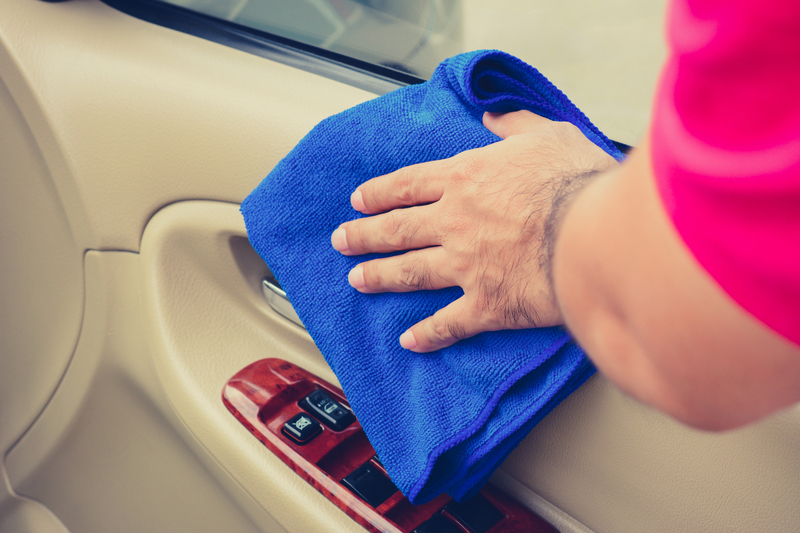Learn the Best Practices to Clean Mould on Sills
Posted on 31/08/2025
Learn the Best Practices to Clean Mould on Sills
Mould growth on window sills and door sills is a common household problem that, if left unchecked, can lead to health issues and structural damage. Learning the best practices to clean mould on sills not only enhances the appearance and longevity of your windows and doors but also safeguards the health of your family. In this comprehensive guide, we'll explore everything you need to know to effectively remove mould from window sills and door sills, prevent its return, and maintain a clean, healthy home environment.

Understanding Mould Growth on Window and Door Sills
What Causes Mould to Grow on Sills?
Mould is a type of fungus that thrives in moist, poorly ventilated areas. Window and door sills are particularly susceptible to mould growth due to condensation, water leakage, and lack of airflow. When surfaces on sills remain damp for extended periods, airborne mould spores can land and start to grow, leading to unsightly spots and potential health hazards.
- High Humidity: Rooms with high moisture levels, such as bathrooms and kitchens, are more prone to mould.
- Poor Ventilation: Limited air movement encourages moisture build-up on sills.
- Condensation: Cold window surfaces can cause condensation, providing a perfect breeding ground for mould.
- Leaking Windows or Doors: Faulty seals or old windows can allow water to seep in and foster mould growth.
Identifying Mould on Sills
Before you learn how to clean mould off sills, it's vital to recognize the early signs. Mould can appear as black, green, or brown spots and often emits a musty odor. Common symptoms of a mould problem on your window or door sills include:
- Visible discoloration or staining
- Peeling paint or bubbling varnish
- Damp, musty smell near windows or doors
- Allergy symptoms such as sneezing, coughing, or watery eyes
If you notice any of these signs, it's time to act quickly to clean the mould from your sills.
Health Risks Associated with Mould on Sills
Ignoring mould growth on window and door sills can have serious health implications. Mould releases microscopic spores into the air, which can trigger allergies, asthma, and respiratory problems, especially in children, the elderly, and individuals with weakened immune systems.
- Allergies: Mould spores can cause skin rashes, sneezing, itching, and red eyes.
- Respiratory Issues: Prolonged exposure can lead to breathing difficulties and worsen asthma.
- Weakened Immune Systems: Those with compromised immunity may be at higher risk for fungal infections.
Therefore, it is crucial to understand the best methods for cleaning mildew and mould off your sills to protect your health and home.
Essential Tools and Materials for Cleaning Mouldy Sills
Before you begin the process of removing mould from window sills, gather the following supplies:
- Protective gloves and goggles
- Face mask or respirator
- Spray bottle
- Soft-bristled brush or old toothbrush
- Microfiber cloths or paper towels
- White vinegar or hydrogen peroxide
- Dishwashing liquid
- Baking soda (optional)
- Warm water
- Bucket
*Make sure to wear appropriate protective gear throughout the cleaning process to avoid direct contact with mould spores.*
Step-by-Step Guide: How to Clean Mould off Sills Safely
1. Safety Precautions First
Start by ensuring your safety:
- Ventilate the area by opening windows and doors.
- Wear gloves, goggles, and a mask to prevent inhalation or skin contact.
- Remove pets and children from the area while you clean.
2. Dry the Area
If the sill is wet or damp, wipe it down with a dry cloth to remove excess moisture. This step is crucial to limit further mould growth during the cleaning process.
3. Apply the Cleaning Solution
- White Vinegar: Pour undiluted white vinegar into a spray bottle, then spray generously over the mouldy areas. Vinegar is a natural mould killer that destroys over 80% of mould species. Let it sit for at least 60 minutes.
- Hydrogen Peroxide: Use 3% hydrogen peroxide as an alternative. Spray it onto the affected sill and allow it to react for 10-15 minutes before scrubbing.
- Soap and Water: For minor mould, mix dish soap with warm water and apply to the sill. This can help lift and remove superficial mould spots.
- Baking Soda Solution: Combine 1 teaspoon of baking soda with 2 cups of water. Shake well and spray onto the surface for added cleaning power.
4. Scrub the Mould Away
Using a soft brush or toothbrush, gently scrub the surface to loosen mould deposits. Be thorough but gentle to avoid scratching wood, vinyl, or other sill materials.
5. Wipe Clean and Dry Thoroughly
After scrubbing, wipe the sill with a clean, damp cloth to remove the cleaner and remaining mould. Then, use a dry cloth or paper towel to completely dry the area--moisture can quickly result in recurring mould.
6. Repeat If Necessary
For stubborn mould stains, you may need to repeat the application and scrubbing process. Be patient; multiple treatments may be required if the mould is deeply ingrained.
Using Commercial Mould Cleaners
Many commercial cleaning products are specifically designed to remove mildew and mould from window sills and door frames. Look for non-toxic, biodegradable solutions if you prefer an eco-friendly approach. Always follow the manufacturer's instructions and test products on an inconspicuous area first.
Tip: Avoid mixing cleaning products, particularly ammonia and bleach, which can produce dangerous fumes.
Preventing Mould from Returning on Sills
While knowing how to clean black mould from window sills is important, prevention is even better. Incorporate these strategies into your home maintenance routine to keep sills mould-free:
Improve Ventilation
- Regularly open windows to allow fresh air to circulate.
- Install exhaust fans in moisture-prone rooms such as bathrooms and kitchens.
- Use a dehumidifier to maintain indoor humidity levels below 60%.
Seal Windows and Doors Properly
- Check for leaks: Inspect sills and frames for cracks or gaps where water can seep in.
- Re-caulk as needed: Replace worn-out caulk or weather stripping to seal out moisture.
Clean Sills Regularly
- Wipe down sills with a dry cloth during your regular cleaning routine.
- Address any minor condensation promptly.
By staying proactive, you can significantly reduce the chances of seeing mould return.
Best Practices for Different Types of Sill Materials
Wooden Window Sills
- Avoid Bleach: Bleach can damage the wood's finish and is less effective at killing mould on porous surfaces.
- Use Vinegar or Hydrogen Peroxide: Both penetrate the wood and successfully eliminate mould spores.
- Dry Immediately: Never leave moisture on wood after cleaning.
Metal or Vinyl Sills
- Mildew Sprays: Commercial sprays can be used safely on these non-porous surfaces.
- Regular Inspection: Monitor for rust or corrosion if metal is frequently exposed to moisture.
Painted or Laminated Sills
- Be Gentle: Strong abrasives can damage painted finishes.
- Test First: Always test a small area before applying cleaners to laminated surfaces.
Eco-Friendly Tips for Cleaning Mould from Sills
If you prefer natural solutions to clean mould on window sills or door sills, try the following:
- Tea Tree Oil: Add one teaspoon to a cup of water, spray, and let it air dry for an all-natural, powerful fungicide.
- Baking Soda Paste: Mix with water to form a paste for gentle scrubbing action without harsh chemicals.
- Lemon Juice: The natural acidity helps to break down mould stains on lighter surfaces.

Frequently Asked Questions About Mould on Sills
Is it safe to clean mould myself?
For small patches (less than one square meter), DIY cleaning is usually safe if you use proper safety gear. For extensive mould growth or recurring issues, consult a professional.
Can I use bleach to clean mould off window sills?
Bleach is not recommended for porous surfaces like wood, as it doesn't penetrate deeply and may not kill all mould spores. Opt for vinegar, hydrogen peroxide, or commercial mould removers designed for the material.
How often should I check my sills for mould?
Inspect window and door sills monthly, especially during humid seasons or after heavy rainfall. Early detection allows for prompt treatment and minimises damage.
What if mould keeps coming back?
Persistent mould indicates an underlying moisture issue. Revisit your ventilation and weatherproofing strategies and consider professional assessment if problems persist.
Conclusion: Take Control of Mould on Sills With the Right Approach
Knowing the best practices to clean mould on sills equips you with effective, safe, and sustainable strategies for a healthy home. By promptly addressing moisture, using proven cleaning methods, and maintaining good ventilation and seal integrity, you can prevent and remove mould from your window and door sills with confidence. Always remember, consistent upkeep is key--regular checks and cleaning are your best defense against unwanted mould reoccurrence on your sills.
If you stay proactive, use the right products, and follow these steps closely, your home will be cleaner, safer, and mould-free all year round. Don't let mould get the upper hand--start implementing these best practices today!





